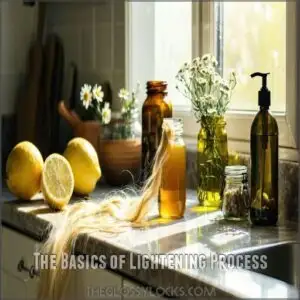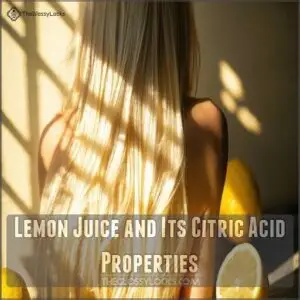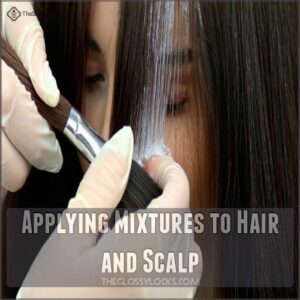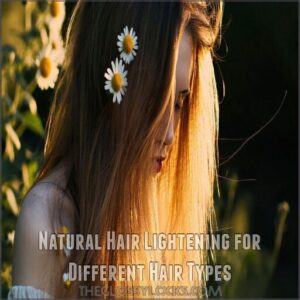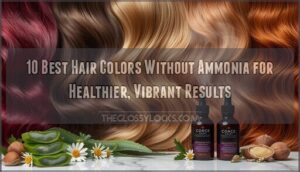This site is supported by our readers. We may earn a commission, at no cost to you, if you purchase through links.
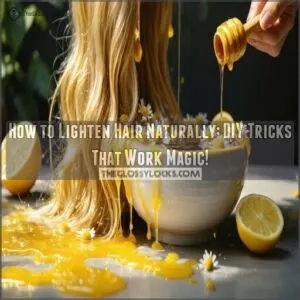
Harness the power of kitchen ingredients like lemon juice, honey, and chamomile tea. These natural lighteners work by gently breaking down melanin in your hair shaft, creating subtle highlights.
Mix fresh lemon juice with water, apply to damp hair, and let sunlight do the work. Honey’s natural hydrogen peroxide can also gradually lift color when mixed with conditioner.
Remember, results vary by hair type and original color—darker hair might need multiple applications. Always do a strand test first, and protect your locks with deep conditioning treatments to maintain hair health and shine.
Table Of Contents
- Key Takeaways
- The Basics of Lightening Process
- Benefits of Natural Hair Lightening Methods
- Natural Ingredients for Hair Lightening
- Preparing and Applying Natural Lightening Mixtures
- Natural Hair Lightening for Different Hair Types
- Maintaining and Enhancing Lightened Hair
- Tips for Safe and Effective Natural Lightening
- Common Mistakes
- Frequently Asked Questions (FAQs)
- How to lighten hair at home without damage?
- How to lighten hair with natural methods?
- What is the best natural hair lightener?
- How to lighten dark blond hair?
- How do I make my hair lighter naturally?
- What lightens hair quickly?
- What is a good substitute for bleach for hair?
- What tea makes your hair lighter?
- Can you lighten your hair with vinegar?
- Can lemon juice ruin your hair?
- Conclusion
Key Takeaways
- You’ll transform your hair color by harnessing the power of natural ingredients like lemon juice, honey, and chamomile tea, which gently break down melanin without harsh chemicals.
- Your hair’s health is paramount, so you’ll need to perform strand tests, protect your scalp, and deep condition after each natural lightening treatment to maintain hair integrity.
- Different hair types require unique approaches, so you’ll customize your lightening technique based on whether you’re a blonde, brunette, or redhead, understanding that results will vary.
- Patience is your greatest ally in natural hair lightening—you’ll achieve subtle, sun-kissed highlights through consistent application, strategic sun exposure, and careful monitoring of your hair’s response.
The Basics of Lightening Process
You’ve probably wondered how to lighten your hair without harsh chemicals, and natural methods offer a promising solution.
Understanding the science behind hair lightening can help you choose the right ingredients and techniques to achieve your desired hair color safely and effectively.
Chemical Reactions Involved in Lightening
At the heart of hair lightening lies a fascinating oxidation process that transforms your hair’s natural pigments.
The delicate dance of chemistry gently unravels your hair’s hidden radiance, one molecule at a time.
The magic happens when hydrogen peroxide or natural agents like lemon juice interact with melanin, breaking down hair pigments through a delicate chemical dance.
Here’s how the molecular magic unfolds:
- Eumelanin molecules get dismantled, revealing lighter underlying tones
- Oxygen triggers pigment breakdown, gradually lifting color
- Hair shaft opens, allowing gentle peroxide activation
The process targets dark eumelanin more aggressively, while pheomelanin’s stubborn yellow-red tones resist more readily.
Citric acid plays a subtle role, helping to disrupt melanin’s molecular structure through precise pH alteration.
Natural lightening methods work slowly but gently, respecting your hair’s intrinsic structure.
Each application is like a microscopic revolution, carefully reducing pigmentation without harsh chemical assault.
Patience becomes your greatest ally in this transformative journey.
Importance of PH Balance in Hair
Your hair’s health hinges on maintaining a desirable pH level between 4.5 and 5.5—a delicate balance that keeps your locks looking vibrant and strong.
When this acidic sweet spot gets disrupted, your hair becomes a rebel, showing signs of distress through dryness and frizz.
| pH Range | Hair Condition | Care Strategy |
|---|---|---|
| 3.5-4.5 | Highly Acidic | Gentle Hydration |
| 4.5-5.5 | Ideal Balance | Maintenance |
| 5.5-6.5 | Slightly Alkaline | Rebalancing |
| 6.5+ | Alkaline | Intensive Repair |
Protecting your hair’s pH is your secret weapon in the natural lightening journey to achieve a healthy and vibrant look.
Role of Natural Ingredients in Lightening
Discovering nature’s secret hair-brightening palette, you’ll discover powerful lightening ingredients that transform your locks without harsh chemicals.
Natural ingredients work magic through unique Ingredient Activation mechanisms that gently alter pigment.
- Lemon Juice: Citric acid powerhouse breaks down melanin under sunlight’s loving embrace
- Honey: Glucose oxidase triggers subtle, moisturizing highlights naturally
- Chamomile: Herbal elixir infusing golden warmth into every strand
These DIY hair lighteners promise gradual, scalp-friendly results that celebrate your hair’s natural beauty.
Understanding Hair Structure and Lightening
The architecture of hair reveals a complex landscape of biological wonder.
Your hair’s structure consists of protective cuticle layers shielding an inner keratin matrix, with melanin pigments determining your natural color.
When exploring hair lightening mechanisms, you’ll encounter two key melanin types: eumelanin (dark pigments) and pheomelanin (red/yellow tones).
Porosity plays a vital role in how lightening treatments penetrate and transform hair strands, influencing the effectiveness of natural hair lightening techniques.
Each strand’s unique composition impacts how it responds to lightening methods, making gentle approaches essential.
By understanding your hair’s intrinsic structure, you can strategically target melanin distribution without compromising cuticle health.
The goal? Achieving your desired tone while maintaining strand strength and integrity.
Hair Aspect Role Impact of Lightening Care Tips
Benefits of Natural Hair Lightening Methods
You’ve probably dreamed of lightening your hair without harsh chemicals that damage your strands and scalp.
Natural hair lightening methods offer you a gentle, cost-effective solution that uses ingredients from your kitchen to subtly transform your hair’s tone while maintaining its health and shine.
Chemical-Free and Damage-Free Options
Ready to transform your locks without harsh chemicals? Natural hair lightening methods offer a gentle path to brighter, healthier hair.
Unlike aggressive bleaching, these techniques provide subtle, damage-free results that nurture your strands from root to tip.
Consider these key advantages:
- Gradual, controlled lightening
- Zero toxic chemical exposure
- Hydrating ingredient-based treatments
- Preservation of hair’s natural integrity
Embrace DIY recipes that work with your hair’s natural chemistry, giving you the freedom to experiment safely and confidently with gentle methods, natural ingredients, and achieve healthier hair while preserving your hair’s natural integrity.
Cost-Effective and Environmentally Friendly
Save your hard-earned cash while loving the planet with smart, natural hair lightening strategies that work wonders.
Your kitchen pantry becomes a treasure trove of DIY hair brightening solutions—think honey, chamomile tea, and lemon juice—offering eco-friendly alternatives that slash chemical usage and reduce waste.
These sustainable ingredients aren’t just budget-friendly; they’re your passport to gorgeous, naturally lightened locks without breaking the bank.
Want a zero-waste approach? Brew a strong chamomile tea or mix sea salt with warm water for a wallet-friendly method that minimizes environmental impact.
By choosing natural hair lightening methods, you’re not just saving money—you’re championing sustainable self-care that’s kind to both your hair and the planet.
Gentle on Hair and Scalp
When money-saving methods meet scalp care, natural hair lightening shines brightest. Your delicate hair craves gentle transformation without harsh chemical assaults.
Embrace nature’s tender touch through mindful lightening techniques that respect your scalp’s ecosystem.
- Protect sensitive skin with mild ingredients
- Minimize breakage through gradual lightening
- Hydrate while subtly changing hair color
- Reduce potential scalp irritation naturally
- Nourish strands with botanical allies
Your hair deserves compassionate, scientific care, which involves understanding the importance of gentle transformation and natural hair lightening.
Customizable and Versatile Techniques
Take control of your hair’s destiny with personalized, natural lightening techniques that are as unique as you are.
Mix and match ingredient combinations to create your perfect DIY hair transformation. From sea salt solutions to honey masks, you’ll discover gradual lightening methods that work with your hair’s natural chemistry.
Each application method offers a custom approach, letting you experiment with natural hair highlights without harsh chemicals. You can also try apple cider vinegar for gentle lightening.
Your hair, your rules – lighten naturally and confidently.
Natural Ingredients for Hair Lightening
You’ve got natural ingredients hiding in your kitchen that can transform your hair’s color without harsh chemicals.
By understanding how substances like lemon juice, honey, and apple cider vinegar interact with your hair’s structure, you’ll discover subtle, sun-kissed highlights that enhance your natural beauty.
Lemon Juice and Its Citric Acid Properties
Got a lemon and a dream of lighter locks? Citric acid transforms your hair with a natural, sun-powered magic trick.
Harness the power of this citrus wonder to create subtle, stunning highlights that shimmer and shine:
- Gently lifts hair color without harsh chemicals
- Most effective on lighter hair shades
- Requires strategic sunlight activation
- Minimizes potential scalp and skin damage
- Always perform a preliminary strand test to ensure the best results with natural and sun-powered magic.
Honey and Its Glucose Oxidase Content
After lemon juice sets the stage for hair lightening, honey emerges as nature’s golden brightener. Its glucose oxidase enzyme quietly works magic, breaking down into microscopic hydrogen peroxide that gently illuminates your strands.
- Discover your hair’s natural radiance with honey’s sweet, subtle alchemy!
Warm water transforms this liquid gold into a lightening elixir. Simply mix honey with water, apply generously, and let time work its magic. The longer you leave the mixture, the more your hair will embrace a softer, sun-kissed glow. Patience becomes your secret weapon in this natural hair-lightening journey.
Apple Cider Vinegar and Its Acidity Level
As you journey from honey’s golden glow to vinegar’s subtle shine, apple cider vinegar emerges as a hair-lightening ally.
Its unique acidity gently strips buildup while lifting color naturally. The magic lies in balanced pH and strategic dilution.
| ACV Type | Dilution Ratio | Hair Impact |
|---|---|---|
| White | 1:3 Water | Cooler Tones |
| Raw | 1:2 Water | Warmer Highlights |
| Filtered | 1:4 Water | Gentle Lift |
Master your hair’s transformation with this kitchen chemistry hack.
Cinnamon, Cardamom, and Other Spices for Boosting Effects
With spices as your secret weapon, transform your hair’s color naturally through a scientifically backed lightening process.
Cinnamon and cardamom aren’t just kitchen staples—they’re hair color alchemists waiting to reveal your inner glow.
- Harness cinnamon’s cinnamaldehyde for golden highlights
- Leverage cardamom’s scalp-strengthening minerals
- Activate honey’s hydrogen peroxide potential
- Craft personalized cinnamon hair lightener masks
The magic happens when these aromatic ingredients dance together, creating subtle, sun-kissed dimensions.
By understanding spice activation and antioxidant benefits, you’ll discover a world of natural hair lightening that celebrates your unique radiance—no harsh chemicals required.
Preparing and Applying Natural Lightening Mixtures
You’re about to transform your hair with scientifically-backed natural lightening techniques that work with your hair’s unique chemistry.
By carefully measuring, mixing, and applying these ingenious homemade treatments, you’ll reveal subtle, sun-kissed highlights.
You will maintain your hair’s health and integrity while achieving the desired look with these natural lightening techniques.
Measuring and Mixing Ingredients
Precision is your secret weapon when crafting natural hair lightening mixtures.
Master the art of ingredient ratios to transform your locks without chemical chaos.
Your DIY hair lightening success hinges on careful measurement and keen observation.
| Ingredient | Quantity | Purpose |
|---|---|---|
| Lemon Juice | 2 tbsp | Lightening |
| Honey | 1 tbsp | Conditioning |
| Water | 1/4 cup | Dilution |
| ACV | 1 tsp | pH Balance |
| Chamomile | 1 tbsp | Subtle Highlights |
Mix with love, measure with precision, and watch your hair glow naturally.
Many seek products for lemon juice treatments to enhance their hair, using lemon juice as a key component for natural hair lightening and achieving subtle highlights with the right mixture.
Applying Mixtures to Hair and Scalp
When you’re diving into at-home hair lightening, grab a tinting brush or clean gloves for precise application.
Work strategically through small sections, ensuring even distribution from roots to ends.
Shield your scalp by applying a thin coconut oil barrier along the hairline.
Consider the various brush types for ideal application.
Your technique matters—gently massage the mixture into strands, respecting your hair’s unique porosity.
Blend carefully to prevent patchy highlights, transforming your locks with careful, intentional strokes and achieve a beautiful look with precise application.
Using Heat, Sunlight, and Other Activators
Solar magic turns your hair lightening quest into a radiant adventure! Heat activates natural lightening ingredients, transforming ordinary mixtures into highlighting powerhouses.
Here’s how to safely amplify your color transformation:
- Harness UV rays to gently brighten strands
- Use warm towels or low-heat dryers strategically
- Apply lightweight moisturizer before sun exposure
- Monitor timing to prevent over-processing
Sunlight interacts with lemon juice and honey, triggering subtle chemical reactions that gradually lift your hair’s natural tone without harsh treatments, making it a natural and gentle way to achieve your desired look, and allowing for a safe transformation.
Timing and Duration of Application
When heat and sunshine amplify your hair lightening process, timing becomes your secret weapon.
Application duration determines your results—shorter treatments (around an hour) deliver subtle shifts, while overnight methods create more dramatic changes.
Limit treatments to once weekly to prevent dryness.
Your hair lightening journey is about patient, gradual transformation, not instant drama.
Natural methods reward those who understand the art of gentle color evolution.
Natural Hair Lightening for Different Hair Types
Your hair’s unique composition determines how effectively natural lightening techniques will work, so understanding your specific hair type is essential for achieving the best results.
By tailoring your approach to your hair’s texture, color, and condition, you’ll maximize the potential of natural ingredients like lemon juice, honey, and chamomile to gently and gradually transform your hair’s shade.
Lightening Techniques for Blonde Hair
Blonde locks crave gentle transformation, and natural lightening methods are your secret weapon.
Spritz lemon juice on damp hair and let the sun work its magic, creating those coveted beachy highlights without harsh chemicals.
A chamomile tea rinse can soften ashy tones while subtly brightening your strands.
Want an extra honey boost? Mix honey with a pinch of cinnamon for a nourishing root touch-up that adds golden warmth.
Remember, your sun exposure matters—protect those delicate blonde tones by limiting direct rays and using protective products.
To avoid damage, consider safer saltwater solutions.
Patience is key when you lighten hair at home.
Lightening Methods for Brunette Hair
Blondes aren’t the only ones who can rock sun-kissed strands! Brunettes, your hair lightening journey starts here with three game-changing natural techniques:
- Brew a honey-cinnamon mask to gradually lift color without harsh chemicals
- Rinse with chamomile tea for subtle, warm highlights that enhance your natural tone
- Spritz sea salt spray for that effortless, beachy lightening effect
Pro tip: Deep condition after each treatment to maintain hair health and avoid those dreaded orange tones. Remember, professional consultation can help you nail the perfect brunette-specific lightening approach, ensuring a natural tone that suits your hair.
Lightening Options for Red Hair
Brunettes seeking lighter locks, meet your redhead companions in the natural hair lightening journey.
Red hair’s unique undertones demand gentle, strategic approaches to gradual lightening.
Discover your copper crown’s transformation potential with these expert techniques:
- Henna alternatives for subtle red-to-strawberry shifts
- Chamomile tea rinses for warm, soft highlights
- Honey and cinnamon masks boosting natural vibrancy
- Apple cider vinegar enhancing reddish undertones
- Lemon juice strategically applied for controlled brightening
Embrace your hair’s natural personality while gently coaxing out lighter, more luminous dimensions—no harsh chemicals required.
Natural Lightening for Damaged or Colored Hair
When caring for color-treated or damage-prone hair, you’ll want to tread carefully with natural lightening techniques.
Gentle, no-damage alternatives can transform your locks without harsh chemicals.
| Hair Type | Treatment | Duration |
|---|---|---|
| Damaged | Honey Mask | 30-60 mins |
| Color-Treated | Olive Oil Blend | 45-90 mins |
| Fragile | Protein Treatment | 15-20 mins |
| Dry | Hydration Mask | 20-30 mins |
| Brittle | Gentle Lightener | 15-45 mins |
Patience becomes your ultimate hair healing companion, and with these methods, you can achieve healthy and beautiful locks.
Maintaining and Enhancing Lightened Hair
After naturally lightening your hair, you’ll want to protect and enhance those beautiful golden strands through strategic care techniques.
Your post-lightening hair care routine should focus on deep conditioning, minimizing heat damage, and using targeted treatments that preserve color vibrancy and strand integrity.
Deep Conditioning and Moisturizing Treatments
After naturally lightening your hair, moisture becomes your ultimate rescue mission.
Deep conditioning transforms stressed strands from brittle to brilliant, offering a lifeline of hydration and repair.
- DIY masks restore hair’s protein balance
- Oil treatments breathe life into damaged locks
- Hydration methods heal from root to tip
Whip up nourishing treatments using kitchen heroes like olive oil, honey, and chamomile tea.
These protein-packed elixirs soothe your scalp and resurrect shine, turning damaged hair into a lustrous crown.
For intensive repair, consider specialized conditioning products.
Your strands will drink in the moisture, revealing a healthy glow that whispers transformation and resilience.
Regular Trims and Hair Care
Your hair’s journey to brilliance starts with strategic maintenance. Regular trims are your secret weapon in the battle against damage and dullness.
Here’s your hair care game plan:
- Schedule professional cuts every 6-8 weeks
- Master gentle brushing techniques
- Invest in silk pillowcases to reduce friction
- Practice protective styling methods
- Prioritize scalp health and hydration
Precision cuts with specialized shears transform split end prevention into an art form. By nurturing your locks from root to tip, you’ll maintain the vibrant, healthy hair that turns heads and boosts confidence.
Avoiding Heat Styling and Harsh Chemicals
Your hair’s health demands a rebellion against heat styling’s tyranny.
Embrace heatless techniques like braids, twists, and soft buns that protect your strands while looking effortlessly chic.
For curly-haired rebels, plopping offers curl definition without damage.
Swap scorching hot tools for gentle drying methods and chemical-free natural alternatives that nourish your locks.
Chemical-free lightening techniques preserve your hair’s integrity, letting your natural beauty shine through without harsh treatments that strip away your hair’s spirit, and this approach allows for a heatless and natural way to care for your hair.
Tips for Safe and Effective Natural Lightening
When you’re keen to lighten your hair naturally, safety and effectiveness are key to achieving your desired look without compromising hair health.
By following expert guidelines and understanding the science behind natural hair lightening techniques, you’ll minimize damage and maximize beautiful, sun-kissed results.
Performing Strand Tests
Before applying any natural hair lightening mixture, safeguard your strands with a precise test:
- Choose a hidden section near the nape
- Mix ingredients at precise concentrations
- Apply carefully, watching color shifts
- Document reaction times painstakingly
Your strand test preview reveals potential damage, color outcome, and safety—transforming hair lightening from risky experiment to controlled science experiment.
Avoiding Over-Processing and Damage
Your strand test reveals promising results, but protecting hair’s integrity is essential.
Limit lightening treatments to once weekly to prevent damage, watching for breakage or increased frizz. A saltwater solution can also lighten hair, but be mindful of potential drying and damage.
- Moisture is your ally: Deep conditioning shields against structural weakness.
By respecting your locks’ limits, you’ll craft sun-kissed highlights without compromising strength. Professional consultation can guide your gentle hair lightening journey, ensuring damage-free, radiant results.
Following Instructions and Guidelines
Because precision is your secret weapon in hair lightening, mastering dosage and application becomes essential.
Each natural method demands painstaking attention to detail—no room for guesswork here. Before proceeding, always perform a patch test to preview potential outcomes and prevent unexpected mishaps.
Read ingredient labels carefully and follow mixing instructions precisely, treating them like a sacred hair lightening roadmap. Watch the clock during treatments, removing them exactly when recommended to avoid over-processing.
Your hair’s unique texture speaks volumes, so listen carefully and adjust accordingly. Professional consultation can provide invaluable insights into your specific hair lightening safety strategy, ensuring you achieve those sun-kissed highlights without compromising hair health.
Being Patient and Consistent
Your hair’s transformation is a science of patience, not an overnight miracle.
Embrace natural lightening’s slow magic with these steps:
- Establish a weekly ritual
- Document subtle shifts
- Protect strands with deep conditioning
- Manage realistic expectations
- Trust the gradual process
Consistent application reveals your hair’s hidden potential.
Each treatment brings you closer to sun-kissed, radiant locks—no rushing, just steady, gentle progress.
Common Mistakes
Your quest for sun-kissed locks can quickly derail without careful technique. Natural hair lightening demands precision and patience.
Here are four critical mistakes to dodge:
- Overuse frequency: Bombarding strands with lightening treatments leads to irreversible hair damage
- Scalp contact: Applying mixtures directly on sensitive skin triggers irritation
- Inconsistent application: Uneven ingredient distribution creates a kaleidoscope of unfortunate color patches
- Ignoring strand tests: Skipping preliminary checks risks unexpected hair breakage and color catastrophes
Navigate these pitfalls to access your hair’s natural, radiant potential.
Over-cleansing, a similar error, can lead to dry and brittle hair, so consider sulfate-free product options.
Frequently Asked Questions (FAQs)
How to lighten hair at home without damage?
Mix honey with water, apply to damp hair, and sit in sunlight.
Use diluted lemon juice or chamomile tea sparingly.
Deep condition afterward.
Test on a small section first to prevent damage and guarantee your desired subtle, natural lightening effect.
How to lighten hair with natural methods?
Craving sun-kissed locks without harsh chemicals?
Naturally lighten your hair using ingredients like lemon juice, honey, and chamomile tea.
Apply strategically, embrace heat, and watch your tresses transform with gentle, DIY techniques that nourish while brightening, achieving sun-kissed locks.
What is the best natural hair lightener?
Lemon juice is your best natural hair lightener.
It subtly lifts color when sprayed on damp hair and activated by sunlight, offering a gentle, chemical-free way to brighten your locks without harsh treatments.
How to lighten dark blond hair?
Like sunlight kissing your locks, honey and chamomile tea can gently lift your dark blond shade.
Dilute, apply carefully, and let natural ingredients work their magic while protecting your hair’s health and shine.
How do I make my hair lighter naturally?
You’ll naturally lighten your hair by applying diluted lemon juice, honey, or chamomile tea, then drying in sunlight.
Gentle techniques like apple cider vinegar rinses and vitamin C treatments can subtly brighten your strands without harsh chemicals.
What lightens hair quickly?
Race against time or sit back and wait?
Hydrogen peroxide mixed half with water quickly lightens hair.
Apply carefully, test frequently, and follow with deep conditioning to prevent damage and maintain hair health.
What is a good substitute for bleach for hair?
Hydrogen peroxide, diluted to half strength, offers a gentler alternative to bleach. Mix with water, apply carefully, and monitor your hair’s reaction to prevent damage while gradually lightening your locks.
What tea makes your hair lighter?
Chamomile tea can subtly lighten your hair, giving a golden tint when applied to damp strands and dried in sunlight.
This gentle method works best for naturally blonde or light-colored hair seeking soft, sun-kissed highlights.
Can you lighten your hair with vinegar?
You can lighten hair with apple cider vinegar (ACV), but it’s subtle.
Dilute it 50/50 with water, apply carefully, and don’t overuse.
It works best on lighter hair, adding warm highlights while balancing your scalp’s pH.
Can lemon juice ruin your hair?
Lemon juice can damage your hair if you’re not careful.
Its acidic nature strips moisture, causing dryness and breakage.
Always dilute it, limit application time, and deep condition to protect your locks from potential harm, using methods that prevent dryness and breakage.
Conclusion
Remarkably, over 60% of hair color enthusiasts now prefer natural lightening methods.
With these DIY tricks for how to lighten hair naturally, you’ve discovered a chemical-free path to gorgeous, sun-kissed locks.
Your kitchen ingredients aren’t just pantry staples—they’re your hair’s new best friends.
Remember, patience and consistency are key.
Whether you’re a blonde, brunette, or redhead, these techniques offer a gentle, personalized approach to achieving your dream hair color without harsh treatments.

